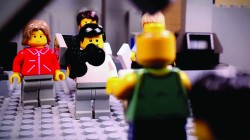Cinema | August 12th, 2015
 Is it possible to make a feature-length documentary chronicling the commercial success, historical context and popular appeal of Lego (stylized as LEGO) building toys without coming across as a corporate shill? Maybe, but the question remains unanswered by Kief Davidson and Daniel Junge in “A Lego Brickumentary,” a geeky, gushing love letter that often feels like an extended television advertisement.
Is it possible to make a feature-length documentary chronicling the commercial success, historical context and popular appeal of Lego (stylized as LEGO) building toys without coming across as a corporate shill? Maybe, but the question remains unanswered by Kief Davidson and Daniel Junge in “A Lego Brickumentary,” a geeky, gushing love letter that often feels like an extended television advertisement.
Junge, who recently helmed the much better “Being Evel,” and Davidson have defended their choices, claiming that the toymaker had zero editorial input. Their filmmaking approach, however, is non-stop hagiography.
The film’s chatty narrator and guide is a relentlessly exuberant Jason Bateman, whose on-screen avatar is a Lego minifigure that causes one to wonder why the directors didn’t just employ the Chris Pratt/Emmet combo from Phil Lord and Christopher Miller’s 2014 smash “The Lego Movie.”
Miller and Lord appear in the “brickumentary” along with a dizzying parade of artists, builders, collectors, moviemakers, designers and dreamers sometimes categorized by acronyms like AFOL (Adult Fan of Lego), popular within the Lego community.
Sadly, Michel Gondry’s clip for the White Stripes’ “Fell in Love with a Girl” is not among the Lego achievements that made the cut.
Quick, breezy overviews of Lego’s origin story and the toy’s irresistible stud-and-tube coupling system and resulting “clutch power” flash by to carve out more time for the snapshots of various Lego maniacs and their specific pursuits.
Coverage of the company’s near collapse in the early 2000s was handled more effectively in Bloomberg’s “Inside Lego.”
The majority of the enthusiasts interviewed on camera are mostly affluent, male and white, and the inclusion of celebrity fans/multimillionaires like Ed Sheeran (whose hits include “Lego House”), Dwight Howard and Trey Parker only reinforces the notion that it takes a significant amount of money to really enjoy the Lego experience.
Women like Alice Finch, co-creator of a jaw-dropping Rivendell model, are few and far between. Finch’s comments encouraging more Lego build/play opportunities for girls are appreciated, but the moviemakers missed an important chance to critically engage with Lego’s address (or lack thereof) of gender.
Accounts of the company’s recent public relations struggles over items like the maligned Friends line, the viral popularity of 7-year-old Charlotte Benjamin’s letter pointing out Lego’s absence of parity and egalitarianism, the classic Rachel Giordano print ad, and the variety of reactions to geoscientist Ellen Kooijman’s proposed and produced Research Institute collection featuring female scientists are completely missing from the movie.
While the skewed male-to-female ratio plaguing Lego minifigures goes unmentioned, the good news is that several of the film’s episodic sequences do provide some insight into aspects of the toy that operate at least partially outside of the purely consumerist (even if these scenes feature a lot of pale dudes). The use of Lego play by Daniel LeGoff in therapy for children with autism, the contributions of Adam Reed Tucker to Lego’s Architecture collection, the stop-motion work of David Pagano, and the synergy between company and end user through the Japan-originated Cuusoo (now Lego Ideas) project are every bit as cool as the movie’s gargantuan product placement featuring the full scale “Star Wars” X-wing starfighter unveiled near the end of the movie.
January 5th 2026
December 29th 2025
December 29th 2025
December 16th 2025
December 9th 2025
_(1)_(1)_(1)_(1)__293px-wide.jpg)

__293px-wide.jpg)
_(1)__293px-wide.jpg)
__293px-wide.jpg)
__293px-wide.jpg)